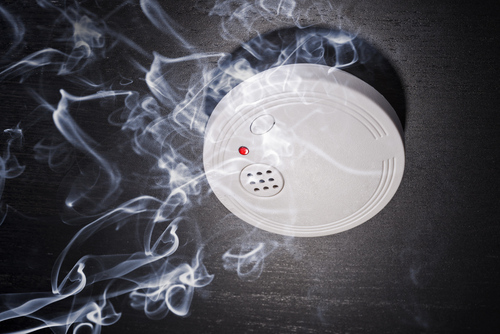
National Fire Prevention Week in Canada is October 9-15, 2016, and Handyman Connection would like to share some important smoke alarm tips that can save not only your life and the lives of your loved ones, but your home as well. Bottom line…installing smoke alarms correctly – and making sure they are in working order – is an important step to making your home and family safer from fire. Here’s what you need to know courtesy of Fire Prevention Canada!
Locating/Installing Smoke Alarms:
- Read and follow the manufacturer’s instructions carefully.
- For best performance, an alarm should be mounted on the ceiling in or near the centre of the room, hall or stairway, and at the head of each stairway leading to an occupied area.
- Optimum location for wall mounts is at least 15 cm from the ceiling but not more than 30 cm from it.
- Avoid installing where the temperature is less than 5°C or exceeds 48°C .
- Keep alarms away from doors and windows.
- Never locate an alarm in front of an air register, fans or vents.
- Keep alarms at least 60 cm (2 feet) from any corner.
- Do not recess smoke alarms in walls or ceilings!
- Smoke alarms in rooms with ceiling slopes greater than 30 cm rise per 2.4 m (eight feet) horizontally should be located on the high side of the room.
- Avoid locating an alarm at the peak of an “A” frame type ceiling.
- Never paint a smoke alarm.
- Keep alarms 60 to 90 cm away from light fixtures.
Tips for Wired Smoke Alarms:
- Use a qualified electrical contractor.
- Never install the alarm in the electrical circuit except at the main panel. Alarms must also never be installed in a circuit connected to an on/off switch.
- Check the alarm when installation is complete.
Testing and Cleaning of Smoke Alarms:
- Test your smoke alarm monthly and clean it every 6 months. Mark it on your calendar so that you don’t forget. Things to remember when testing your smoke alarm:
- Ensure that power is being transmitted to the alarm and that it will activate in the presence of smoke.
- Test your smoke alarm by pressing the test button.
- Even alarms with a pilot light that indicate power is being transmitted, should be tested regularly.
- Battery-operated smoke alarms will warn you when batteries need replacing. Despite this, make it a habit to change the batteries yearly.
- When you’ve been away from home for a few days, check your alarm on your return to ensure it is working properly.
- Remember, your smoke alarm can’t protect you if the batteries have been removed or a plug has been disconnected.
- The lifespan of a typical smoke alarm is about 10 years, but some models last as little as 5 years.
- To clean the alarm, open the cover and gently vacuum the interior of it. Frequently, the alarm will sound while the unit is being cleaned.
Proper smoke alarm installation, maintenance and testing in your home can make a measurable difference in reducing deaths and injuries from fire. Call on the experts at Handyman Connection to help you properly install and maintain your home’s smoke alarms.
